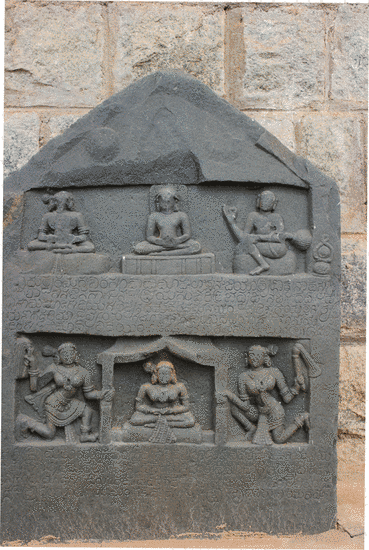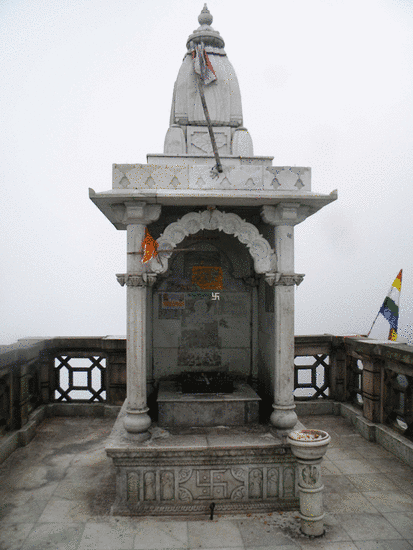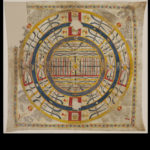Article: Sacred pavilions
Pavilions form sacred architectural spaces of veneration, which house simplified representations of revered beings, particularly Jinas and other enlightened teachers. They are generally quite simple structures yet, over time, they may develop into larger Jain temples.
Religious architecture in South Asia frequently undergoes many stages in its development from minimal towards properly constructed sacred buildings. Often, it is simply a venerated footprint – pādukā – or image raised on a low platform by the wayside, which marks the start of an architectural development and place of worship. The next step in the development is often to increase the height of the platform and to raise a sheltering roof above the revered object to create a simple pavilion.
Such pavilions are very common at sites of Jain veneration and often mark the enlightenment sites of significant teachers, housing figural statues and symbolic representations.
Pavilions are an important element of the Jain architectural repertoire. A pavilion may be used as a centre of worship in its own right as well as forming one or more elements of the different types of Jain temple architecture.
The pilgrimage paths leading up most sanctified Jain hills are lined by such sacred pavilions, which are often arranged in small groups. Examples of such paths can be found at Bamanvad, Rajasthan.
There are also examples where small pavilions have been raised from the ground on pillars to elevate the objects of veneration.
Open-air shrines

A hero stone depicting liberation
Image by Dinesh Kannambadi © CC BY-SA 3.0
In the Indian subcontinent, holy images are frequently displayed in the open, at places considered to be of particular sacred importance. These open-air objects are venerated as part of ritual worship.
Sacred objects are erected on the summit of hills, next to rivers or lakes and below trees. Furthermore, scattered statues and damaged sculptures have often been grouped together inside Jain temple compounds and displayed in a formalised way. In fact most Jain temples in the south of India display such open-air assemblies of statues. These include:
- symbolic and figural representations of the guardian of the temple complex – kṣetra-pāla – which in the south is usually referred to as Brahmadeva
- snake stones – nāga-kals
- hero or memorial stones
- natural objects regarded as sacred or precious, such as round river pebbles, coconuts or flowers, which is a folk practice found among several Indian religions
- figural representations of Jinas or Jain martyrs, which are quite rare.
These venerated objects have usually been raised on low terraces made of stone, and today also of concrete. These shrines are not usually topped by roof elements, however. Instead, the boundary of the small consecrated areas is often marked by rows of low pillars or stone blocks.
In southern India, groups of openly displayed images are usually found on the left side of the main temple structure, towards the back of the compound. Well-known examples are the temples at Mudabidri, Karnataka. Additionally, the enclosure wall – prākāra – at the back of temple complexes can at times be lined by similar representations, usually of snake stones – nāga-kals – or memorial stones. Such snake stones can be seen in the Jain temple at Bhatkal, Karnataka. A good example of a memorial or hero stone is found in the Kedareshvara temple in Balligavi, Karnataka.
Images at the side and back of temples are revered when worshippers walk around the central shrine as part of the religious rite of circumambulation – pradakṣiṇā.
Shape of sacred pavilions

Shrine to Lord Abhinandana
Image by Bodhisattwa © CC BY-SA 4.0
Slightly more elaborate than open-air shrines are simple pavilions, referred to as chatrīs or caraṇas, which have been raised above holy objects, such as temple guardians or hero stones. They are mostly small and square, with roofs that may be domed or topped by temple towers also typical of larger religious structures. These pavilions may be extended to form small walled temples, as the religious site develops.
Most chatrīs are made of stone, usually white marble or red sandstone, such as those in Mount Bahubali at Kumbhoj, Maharashtra. The vast majority have open sides, consisting of four corner pillars, and a small roof. In other instances the sides and back have pierced stone screens – jālīs – creating a semi-enclosed space inside. This type is typical of the pilgrimage site of Mount Paraśnātha in Bihar, for instance. Chatrī pavilions of plastered brick can also have solid walls and represent miniature versions of shrines.
Most pavilions are square in plan although there are octagonal examples. They do not usually measure more than half a metre in diameter, with a basement section, typically of similar dimensions. Most chatrīs are domed, pointing towards a construction date from about the 15th century onwards. Others display a north Indian – nāgara – roof element – śikhara – also found in larger temple structures. A smaller number displays very individualised roof decorations in fairly unusual shapes.
Over time, the sides of such pavilions can be completely enclosed and a porch added at the front, transforming them into proper small temple structures. In other instances, small shrines have replaced places of open-air worship. This illustrates general change and development, which religious sites commonly undergo in history.
Holy objects inside pavilions
The vast majority of Jain pavilions have been built around the sacred foot imprints – pādukās – of holy individuals. These are usually the Jinas or more recently deceased Jain teachers. They may also contain commemorations of lay Jains who died a religious death, representations of mythological events and Jain cosmology. Many pavilions celebrate the liberation of the soul, which is a central Jain belief.
In most cases, chatrī pavilions house the pādukās of one or several of the Tīrthaṅkaras. Due to different iconographic and ritual conventions, Śvetāmbara and Digambara Jains can only worship their own figural statues. However, the veneration of more abstract footprints in simple pavilions allows followers of both sects to pay homage to the same sacred object. As such, pavilions built around pādukās of the Jinas act as an integrative element in Jain religious practice.
The pavilions can also house the footprints of medieval or more recently deceased Jain saints and teachers. This stresses the importance which teachers – gurus – hold in Jainism, a religion which is strongly built on mendicant lineages or ‘pupillary descent’.
More rarely, such simple pavilions can also contain hero stones, commemorating:
- members of the lay community who have died in the selfless rite of sallekhanā – a voluntary religious death by fasting
- Jain martyrs mainly from the period of Islamic invasions.
Examples of such pavilions can be found at the base of Bamanvadji Hill, Rajasthan.
Small representations of the mythical teaching assembly – samavasaraṇa – and Jain cosmological representations can also be displayed inside open pavilions, as may be seen on Mount Śatruñjaya in Gujarat and at Jaisalmer in Rajasthan.
Some pavilions also contain inscription panels. These are revered as they were erected by pious kings and queens who supported Jainism. Many list and glorify the holy deeds of devotees and their revered teachers, such as those on Candra-giri Hill at Shravana Belgola in Karnataka.
Relatively unusual is the combination of sculptures of human figures with more abstract pādukās. An example of this is the Rajasthani site of Bamanvad.
Pādukā pavilions are frequently used to mark the site of enlightenment of a saint or teacher. This is also true of open-air foot imprints, which have not yet been housed inside a structure. Many examples of both can be seen on Mount Droṇa-giri in Maharashtra, where boards naming the deceased are next to many caraṇas. Another example from the same Indian state can be seen at the base of Bāhubali Hill, where the chatrī of Siddha Sena Muni Mahārājjī bears a commemorative inscription.
The aniconic form of representation of the pādukās illustrates particularly well the religious belief that, on reaching full enlightenment, the soul leaves the physical body and entered a bodiless state as a siddha.
Pavilions on pillars

Māna-stambha in front of a temple
Image by rajkumar1220 © CC BY 2.0
Sacred pavilions usually raise the objects of veneration a metre or so from the ground. In south India, pavilions can also be positioned on short pillars, which raise them to eye level. Much smaller pavilions on very tall pillars are found throughout India and are called māna-stambhas. There are also brahmadeva-stambhas, which contain statues of the protective deity Brahma or Brahmadeva. Visible from some way off, these tall columns serve as identifiers of Jain temples as well as elements in ritual practice.
Sometimes the pillars are relatively short, only about one to one and a half metres high. This raises the shrines to a comfortable height for a standing devotee to venerate the images inside the small structure. Such pillars are particularly widespread in the south of India. A famous example is the column in the Digambara Pārśvanātha Temple at Hassan, in Karnataka.
Other pavilions, however, have clearly been elevated far above human level on columns which are about five to ten metres tall. These are not immediately accessible to worshippers on the ground. This is related to the common south Indian Jain practice of erecting pillars topped by images, symbols and lamps.
There are two major forms of these tall pillars topped by small pavilions. Particularly common are māna-stambhas – ‘pride pillars’. These are votive columns, usually at the front of Jain temples. Māna-stambhas are topped by a small pavilion, which usually houses four adorsed Jina statues – figures with their backs turned towards one another and looking outwards – or simply a single image of a Jina. Māna-stambhas are found throughout the Indian subcontinent, especially in Digambara temples.
Closely related in design are pillars dedicated to the yakṣa Brahma or Brahma-deva, who functions as the kṣetra-pāla, the guardian of the sacred area, in Jain temple complexes. He is particularly popular in the south of India. Brahma-stambhas or brahmadeva-stambhas are surmounted by a figure of Brahma. In most instances, he is seated in a small raised pavilion, as may be seen at Halebid and Shravana Belgola, both in Karnataka.
Elevating the holy items means they are visible from afar. Consequently, they do not act only as objects of veneration at the site, but also gain a more symbolic value, so that a place is recognised as Jain from a distance.
Reading
- Jaina Temple Architecture in India: The Development of a Distinct Language in Space and Ritual
Julia A. B. Hegewald - Monographien zur Indischen Archäologie, Kunst und Philologie series; volume 19
Stiftung Ernst Waldschmidt, G+H Verlag; Berlin, Germany; 2009
- ‘Sacred Symbols: Enlightened Beings and Temple Guardians: The Display of Holy Elements on Pillars in Jaina Temple Complexes in Karnataka’
Julia A. B. Hegewald - The Jaina Heritage: Distinction, Decline and Resilience
edited by Julia A. B. Hegewald
Heidelberg Series in South Asian and Comparative Studies series; volume 2
Samskrti Publishers; Delhi, India; 2011
- +
- aAbhavya
- aAbhinandana
- aAbhiṣeka
- aĀcāra
- aĀcārāṅga-sūtra
- aĀcārya
- aAchalbhrata
- aAḍhāī-dvīpa
- aAdharma
- aAdho-loka
- aAdhyayana
- aAdvaita Vedānta
- aĀgama
- aAghātīya
- aAghātīya-karman
- aAgnibhuti
- aAgra
- aĀhāra
- aAhiṃsā
- aAhimsa Day
- aAjita
- aAjīva
- aAkampit
- aĀkāśa
- aAkbar the Great
- aAkṣaya-tṛtīyā
- aAlauddin Khalji
- aAlbert Einstein
- aAllah
- aAlms
- aĀlocanā
- aAloka-ākāśa
- aAmāri
- aAmbikā or Kūṣmāṇḍinī
- aAnagāra
- aAnanta
- aAnarthadaṇḍa
- aAnaśana
- aAnekānta-vāda
- aAṅga
- aAniconism
- aAnojjā
- aAntarāla
- aAntarāya-karma
- aAṇu
- aAṇu-vrata
- aAnukampā
- aAnuprekṣā
- aAnusvāra
- aApabhraṃśa
- aAparigraha
- aAra
- aĀrambha
- aĀrambhaja
- aĀratī
- aArdhamāgadhī Prākrit
- aArhaṃ
- aArhat
- aArśana-āvaraṇīya-karma
- aĀrta-dhyāna
- aĀryikā
- aĀryikā Jñānamati
- aĀśātanā
- aĀścarya
- aAscetic
- aAsceticism
- aAshram
- aAspiration
- aĀsrava
- aAṣṭa-maṅgala
- aAṣṭāpada
- aAstikāya
- aAstrolabe
- aAsura
- aAtheism
- aAticāra
- aAtiśayakṣetra
- aAtithisaṃvibhāgavrata
- aĀtma-vāda
- aĀtman
- aAuṃ
- aAurangzeb
- aAuspicious
- aAusterity
- aAvadhāna
- aAvadhi-jñāna
- aĀvaraṇī-yakarman
- aAvasarpiṇī
- aAvatāra
- aAvidyā
- aAxiom
- aĀyāga-paṭa
- aĀyambil
- aĀyu-karma
- aĀyurveda
- bBabur
- bBāhubali
- bBaladeva
- bBālāvabodha
- bBandha
- bBasadi
- bBazaar
- bBhadrankarvijay
- bBhagavant
- bBhaktāmara-stotra
- bBhakti
- bBhale
- bBharata
- bBhāṣā
- bBhāṣya
- bBhaṭṭāraka
- bBhāva
- bBhāva-pūjā
- bBhāvanā
- bBhavana-vāsin
- bBhavya
- bBhavyatva
- bBhaya
- bBhoga-bhūmi
- bBhogopabhoga
- bBodhi
- bBollywood
- bBrahmā
- bBrahma-deva
- bBrahmacārī
- bBrāhmaṇa
- bBraj Bhāṣā
- bBright fortnight
- bBritish Raj
- bBuddha
- bBuddhi-sagar
- bBuddhism
- bBuddhist
- cCaitya
- cCaityavāsin
- cCakravartin
- cCakreśvarī
- cCāmara
- cCandanā
- cCandragupta
- cCandraprabha
- cCanon
- cCāritra
- cCāritramohanīya-karman
- cCarũrī
- cCaste
- cCaturvidha-saṅgha
- cCaturviṃśati-stava
- cCāturyāma
- cCE
- cCelibacy
- cCha
- cChadmastha
- cChastity
- cCheda-sūtra
- cChristian
- cChristianity
- cClergy
- cCloning
- cColophon
- cCommentary
- cConch
- cConfession
- cCongregation
- cConsecration
- cCosmology
- cCremation
- cCrore
- cCult
- cCūrṇi
- dDādā-guru
- dDalit
- dDāna
- dDaṇḍa
- dDark fortnight
- dDarśana
- dDarśanamohanī-yakarman
- dDaśa-lakṣaṇa-parvan
- dDeity
- dDelhi Sultanate
- dDerāsar
- dDeśāvakāśika-vrata
- dDetachment
- dDevanāgarī
- dDevānandā
- dDevarddhi-gani
- dDevotee
- dDhamal
- dDhanuṣ
- dDhāra
- dDharma
- dDharma-dhyāna
- dDharma-sāgara
- dDharmastikaya
- dDhātakīkhaṇḍa
- dDholak
- dDhyāna
- dDiaspora
- dDig-vrata
- dDigambara
- dDīkṣā
- dDisciple
- dDīvālī
- dDivya-dhvani
- dDNA
- dDoctrine
- dDogma
- dDonor
- dDoṣa
- dDravya
- dDravya-pūjā
- dDrone
- dDuṣamā
- dDuṣamā-duṣamā
- dDuṣamā-suṣamā
- dDveṣa
- dDvīpa
- eEast India Company
- eEightfold Path
- eEkānta-vāda
- eEkendriya
- eElder
- eElders
- eEschatology
- eEtc up to
- fFarmān
- fFast
- fFatehpur Sikri
- fFestival
- fFestschrift
- fFiruz Shah
- fFly-Whisks
- fFolio
- fFour Noble Truths
- gGaccha
- gGaṇa
- gGaṇadhara
- gGanadharavada
- gGaṇeśa
- gGaṇin
- gGarba
- gGarbha
- gGarbha-gṛha
- gGaruḍa
- gGati
- gGene
- gGenomics
- gGhātī-yakarman
- gGhātīya
- gGhaznavid
- gGhiyasuddin Tughlaq
- gGhurid
- gGloss
- gGotra-karma
- gGujarāt
- gGujarati
- gGuṇa
- gGuṇa-sthāna
- gGuṇa-vrata
- gGupti
- gGuru
- gGuruṇī
- hHagiography
- hHajj
- hHaṃsa
- hHaribhadra
- hHariṇaigameṣin
- hHasta
- hHeresy
- hHiṃsā
- hHindi
- hHindu
- hHinduism
- hHīravijaya
- hHoroscope
- hHrīṃ
- hHumayun
- hHymn
- iIconoclasm
- iIconography
- iIdol
- iIndian Independence
- iIndology
- iIndra
- iIndrabhūti Gautama
- iIndriya
- iInitiation
- iIntercession
- iInvocation
- iIQ
- iIslam
- iIslamicate
- iIṣṭadevatā
- iĪśvara
- jJagat
- jJahangir
- jJain
- jJaina Devanāgarī
- jJaina Śaurasenī
- jJaina-dharma
- jJainaśāsana
- jJainness
- jJaisalmer
- jJamāli
- jJambū-dvīpa
- jJames Burgess
- jJanma
- jJanma-kalyāṇa
- jJarā
- jJāti
- jJina
- jJina-āgama
- jJina-bhavana
- jJina-bimba
- jJina-mātā
- jJinacandra-sūri
- jJinadatta
- jJinaprabha
- jJīva
- jJñāna
- jJñāna-āvaraṇīya-karma
- jJñāna-āvarṇiya
- jJñānsundar
- jJyotiṣka
- kKāla
- kKālakācārya-kathā
- kKālidāsa
- kKalpa-sūtra
- kKalpa-vṛkṣa
- kKalyāṇaka
- kKalyanvijay
- kKamaṇḍalu
- kKamaṭha
- kKarma
- kKarma-bhūmi
- kKarma-grantha
- kKarma-prakṛti
- kKarma-vāda
- kKarmon
- kKarnataka
- kKaṣāya
- kKathā
- kKāvya
- kKāya
- kKāyotsarga
- kKeśa-loca
- kKetu
- kKevala-jñāna
- kKevalin
- kKhalji
- kKharatara-gaccha
- kKnowledge
- kKriyā
- kKriyā-vāda
- kKṛṣṇa
- kKṣamā-śramaṇa
- kKṣapakaśreṇi
- kKṣatriya
- kKṣullaka
- kKulakara
- kKundakunda
- kKunthu
- lLabdhi
- lLaity
- lLakh
- lLāñchana
- lLands of Action
- lLaukāntika
- lLavaṇa-samudra
- lLeśyā
- lLiṅga
- lLinguistics
- lLoka
- lLoka-ākāśa
- lLoka-puruṣa
- lLoka-vāda
- lLotus
- lLotus lake
- mMadhya-loka
- mMahā-videha
- mMahā-vrata
- mMahābhārata
- mMahāmastakābhiṣeka
- mMāhārāṣṭra
- mMāhārāṣṭrī Prākrit
- mMahattarā Yākinī
- mMahāvīr Jayantī
- mMahāvīra
- mMakāra
- mMakkhali Gośāla
- mMalli
- mMāna-stambha
- mManaḥ-paryāya-jñāna
- mMaṇḍala
- mMaṇḍapa
- mMandit
- mMaṅgala
- mMantra
- mMantras
- mManuṣya-loka
- mMarāṭhī
- mMārgaṇā
- mMartyr
- mMarudevī
- mMaṭha
- mMati-jñāna
- mMauryaputra
- mMecca
- mMendicant lineage
- mMetarya
- mMiracle
- mMithyādṛṣṭi
- mMohandas Gandhi
- mMohanīya-karma
- mMokṣa
- mMonastic order
- mMonasticism
- mMonk
- mMonotheism
- mMosque
- mMount Meru
- mMount Sammeta
- mMṛgāvatī
- mMughal
- mMuhammad
- mMuhammad bin Tughlaq
- mMuhpattī
- mMūla-sūtra
- mMūlaguṇa
- mMumbaī
- mMuni
- mMunisuvrata
- mMurad Bakhsh
- mMūrti-pūjaka
- mMuslim
- mMysticism
- nNābhi
- nNāga-kal
- nNāgapurīya Tapā-gaccha
- nNāgarī
- nNāma-karma
- nNamaskāra-mantra
- nNami
- nNandīśvara-dvīpa
- nNandivardhana
- nNandyāvarta
- nNāraka
- nNāraki
- nNasalisation
- nNātha
- nNavrātrī
- nNaya-vāda
- nNemi
- nNidāna
- nniggaṃthāṇa vā 2
- nniggaṃtho vā 2
- nNigoda
- nNihnava
- nNikṣepa
- nNirgrantha
- nNirjarā
- nNirvāṇa
- nNiryukti
- nNiṣidhi
- nNitya
- nNiyati
- nNo-kaṣāya
- nNudity
- nNun
- oOcean of milk
- oOmniscience
- oOrdination
- ppa°
- pPadmaprabha
- pPadmāsana
- pPadmāvatī
- pPādukā
- pPalanquin
- pPalette
- pPañca-muṣṭi
- pPāṇḍava
- pPaṇḍit
- pPandit Dalsukh D. Malvania
- pPandit Sukhlalji
- pPāṇipātra
- pPāpa
- pParamātman
- pParameṣṭhin
- pPāraṇā
- pParigraha
- pPariṇāma
- pParīṣaha
- pParokṣa
- pPārśva
- pPārśvanātha
- pParyāya
- pParyuṣaṇ
- pPaṭa
- pPatan
- pPātra
- pPenance
- pPersian
- pPhala
- pPhilology
- pPicchikā
- pPilgrimage
- pPīr
- pPolymath
- pPoṣadha
- pPossession
- pPothī
- pPrabhas
- pPradakṣiṇā
- pPradeśa
- pPrākāra
- pPrakīrṇaka-sūtra
- pPrākrit
- pPramāda
- pPramukhā
- pPrati-vāsudeva
- pPratikramaṇa
- pPratimā
- pPratiṣṭhā
- pPratyākhyāna
- pPratyakṣa
- pPravacana
- pPrāyaścitta
- pPrayer
- pPre-modern
- pPreach
- pPredestination
- pProtestant
- pProvenance
- pPudgala
- pPūjā
- pPujārī
- pPukharavara-dvīpa
- pPuṇya
- pPūrva
- pPuṣkara-dvīpa
- pPuṣpadanta
- pPyre
- qQur’an
- rRāga
- rRāhu
- rRainy season
- rRajasthan
- rRajasthani
- rRājimatī
- rRajoharaṇa
- rRajput
- rRāma
- rRāmāyaṇa
- rRangoli
- rRās-garbā
- rRasa
- rRathanemi
- rRatna-traya
- rRātri-bhojana
- rRaudra-dhyāna
- rRecto
- rRelic
- rRenunciation
- rRetroflex
- rRevatī
- %Ṛg-veda
- rRite
- rRosary
- %Ṛṣabha
- %Ṛṣabhanātha
- rRupee
- sSaciyā Mātā
- sSādhu
- sSādhvī
- sSāgāra
- sSaint
- sŚaivaism
- sŚaka-saṃvat
- sSallekhanā
- sŚalya
- sSamacatuṣṭha
- sSamādhimaraṇa
- sSamaṇi
- sSāmarambha
- sSamavasaraṇa
- sSāmāyika
- sSaṃbhava
- sSamiti
- sSaṃjñā
- sSaṃkalpaja
- sSaṃsāra
- sSamudghāta
- sSaṃvara
- sSaṃvega
- sSamyak-cāritra
- sSamyak-darśana
- sSamyak-jñāna
- sSamyaktva
- sSaṃyama
- sSanctuary
- sSandalwood
- sSaṇgha
- sSanskrit
- sSant
- sŚānti
- sSapta-bhaṅgi-naya
- sSārambha
- sSarasvatī
- sSarvajña
- sSāsan-devi
- sŚāsana-devatā
- sŚāstra
- %Ṣaṭ-jīvanikāya
- sSatī
- sSatīmātā
- sSatya
- sSchism
- sScribe
- sScripture
- sSect
- sSecularism
- sŚenāī
- sSermon
- sŚeṣavatī
- sSevā
- sSeven fields of donation
- sShah Jahan
- sShantidas Jhaveri
- sShrine
- sSiddha
- sSiddha-śilā
- sSiddhacakra or Navadevatā
- sSiddhānta
- sSiddhārtha
- sSiddhi
- sSikh
- sSikhism
- sŚikṣā-vrata
- sŚīla
- sSin
- sSindh
- sŚītala
- sŚiva
- sSkandha
- sSomanatha
- sŚraddhā
- sŚramaṇa
- sŚrāvaka
- sŚrāvakācāra
- sŚrāvikā
- sŚreyāṃsa
- sŚrī
- sŚrīvatsa
- sŚruta-jñāna
- sŚruta-pañcamī
- sSthānaka-vāsin
- sSthāpanācārya
- sSthāvara
- sSthavira
- sSthiti
- sStrīmukti
- sStūpa
- sSubcontinent
- sSudarshana
- sŚuddhi
- sSudharma
- sŚūdra
- sSufism
- sSukha
- sŚukla-dhyāna
- sSulasā
- sSultan
- sSumati
- sSundarśrī
- sSupārśva
- sSūri
- sSuṣamā
- sSuṣamā-duṣamā
- sSuṣamā-suṣamā
- sSūtra
- sSuyam me ausam! Tenam bhagavaya evamakkhayam
- sSvādhyāya
- sSvāhā
- sSvastika
- sŚvetāmbara
- sŚvetāmbara Terāpanthin
- sŚvetāmbaras
- sSwan
- sSyād-vāda
- tTabla
- tTantra
- tTapā-gaccha
- tTapas
- tTāraṇ Svāmī Panth
- tTattva
- tTattvārtha-sūtra
- tTemple
- tTemple-city
- tThe Enlightenment
- tTheology
- tThree worlds
- %Ṭīkā
- tTilaka
- tTīrtha
- tTīrthaṃkaranāma-karman
- tTīrthankara
- tTransliteration
- tTrasa
- tTrasa-nāḍī
- tTriśalā
- tTriṣaṣṭi-śalākā-puruṣa-caritra
- tTti bemi
- tTughlaq
- tTunk
- uUdumbara
- uUniversal History
- uUpādhyāya
- uUpāṅga
- uUpaniṣads
- uUpāsaka
- uUpasarga
- uUpāśraya
- uŪrdhva-loka
- uUtsarpiṇī
- uUttarādhyayana-sūtra
- vVāhana
- vVaimānika
- vVairāgya
- vVaiṣṇava
- vVaiśramaṇa
- vVaiśya
- vValabhī
- vVanaspatikāya
- vVandana
- vVaṇik
- vVarṇa
- vVāsudeva
- vVāsupūjya
- vVayubhūti
- vVeda
- vVedanīya-karma
- vVegetarianism
- vVehicle
- vVernacular
- vVerso
- vVidyā
- vVidyā-devī
- vVihāra
- vVijñapti-patra
- vVikrama-saṃvat
- vVikṛti
- vVimala
- vVinaya
- vVipāka
- vVirji Vora
- vVirodhaja
- vVīrya
- vVisarga
- vViṣṇu
- vVītarāga
- vVizier
- vVotive
- vVow
- vVrata
- vVS
- vVyakta
- vVyantara
- vVyasana
- yYakṣa
- yYakṣī
- yYantra
- yYaśoda
- yYaśovijaya
- yYati
- yYātrā
- yYoga
- yYoginī
- yYojana








